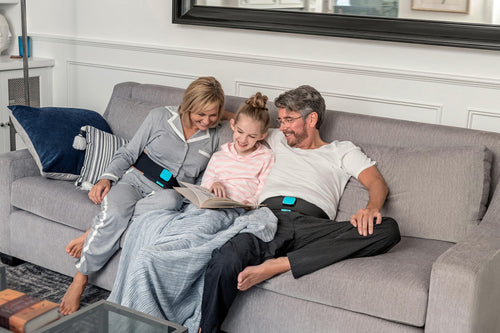Whether you’re a beginner or a professional seasonnaire, strong back, abdominal and pelvic muscles are essential for improving stability, balance and agility on and off the pistes. Daisy Maddinson, from Mountain Mavericks in Morzine, France, shares her top pre-season skiing and snowboarding training tips.
Prepare your body for the winter season
Training for the winter season is vital if you want to make the most of your time in the mountains.
Strength exercises like squats, deadlifts, bench press and overhead press are perfect for maintaining core and leg strength.
Regular cardio helps keep your fitness and stamina high in preparation for long and demanding days too.
Strength, balance and flexibility are key factors in maintaining good form and technique, so activities like yoga and Pilates are great additions to your training routine.
How does Slendertone prepare for the slopes?
Dom (from the London office) recommends lunges to work the legs and Russian twists to strengthen the obliques.
“These exercises are essential for sharper turns and manoeuvring moguls,” he says.
Laura (from our office in Paris) drills these exercises to improve her posture and balance:
- Hold the squat position against a wall (as if you’re sitting on a chair) to work the quads.
- Hold the plank position to exercise your abdominal muscles and enhance core strength.
- Lying on an exercise ball, bend your legs at 90° and press the heels into the floor to raise the pelvis. This increases back strength.
- To improve endurance and coordination, practise skipping.
To build core and abdominal strength and endurance, a Slendertone abs belt is the perfect accessory for your pre-season training programme.
Control your breathing to engage your core
Engaging your core effectively can be difficult, but better breathing can help improve your control.
Most people breathe by raising the shoulders and ribcage and inhaling into their chest. This is far too shallow to fully utilise the diaphragm, which limits the power of the core muscles.
Instead, practise breathing into the deepest part of your belly to engage your core more.
Skiing or snowboarding? Do what feels natural!
As a beginner, trying to figure out whether you prefer skiing or snowboarding can be tricky, however the only real question you need to ask yourself is: ‘What feels most natural?’
If you’ve done skating or surfing you’ll likely find boarding an easier, more comfortable transition. Ice skaters and rollerbladers, however, may prefer skiing.
The best advice is to try both and then decide!
Moulded ski/snowboard boots and a technical layering system will further help improve comfort and performance on the snow.
Pick your perfect resort
Beginners
Les Gets-Morzine is ideal for beginners. It’s fairly flat, the ski areas are easy to access from town and the pretty alpine villages are a great introduction to the essence of European winter sports holidays.
Skiing
Chamonix, home to the famous Mont Blanc, is a world-renowned resort ideal for skiers. Bountiful in technical backcountry skiing and interesting pistes, Chamonix boasts a wide range of exciting terrain.
Snowboarding
Whistler, Canada, should be at the top of the to-do list. Large North American snowfalls, famous tree runs and a selection of great parks make Whistler the perfect playground for snowboarders.
Backcountry
Verbier, Switzerland, is a firm favourite for backcountry riders and it’s no surprise it plays host to the Freeride World Tour. With so much pristine terrain accessible from this resort, it’s just asking for you to get out there and paint your own line.
Families
La Plagne in the French Alps provides a great base for family adventures. Part of the larger Paradiski, La Plagne offers an extensive and varied ski area with well-kept nursery slopes and a family-friendly atmosphere.

